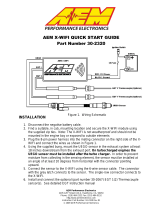Page is loading ...

ADVANCED ENGINE MANAGEMENT INC.
This product is legal in California for racing vehicles only and should never be used on public highways.
Advanced Engine Management, 2205 126
th
Street Unit A Hawthorne, CA. 90250, Phone: (310) 484-2322 Fax: (310) 484-0152
Instruction Part Number: 10-361, © 2006 Advanced Engine Management, Inc.
-40C to +1000C EGT SENSOR
AEM P/N 30-2050
This RTD Style EGT sensor is specifically designed to monitor high temperature environments in the automotive
applications.
The 30-2050 kits contains:
One RTD temperature sensor with male connector and male thread.
One mating connector assembly.
One weld-on bung w/female thread.
Temperature Range: -40°C to 1000°C
Protective Tube Material: Mat. No. 2.4816 INCONEL ALLOY 600
Sensor Thread: M14 x 6H – iso 965-2
Sensor Element: Platinum sensor in thin film technology
Nominal Resistance of Element: 200Ω at 0°C
Accuracy: Including ageing (500 hr @ 950°C), not
Including electronics.
• From -40°C to 200°C: ± 3°C
• From 200°C to 1000°C: ± 1.5°C
Characteristic Curve: Almost linear from -40°C to 1000°C
Temp 0°C 100°C 200°C 300°C 400°C 500°C 600°C 700°C 800°C 900°C 1000°C
Ohms 200 275 348 419 488 554 617 679 738 794 849
Disturbances: Very insensitive to external disturbances (gas flow, splash water…) due to good thermal decoupling of
measurement element.
Response time:
Initial Temperature
23 °C 23 °C 300 °C 300 °C
Final Temperature
205 °C 300 °C 600 °C 600 °C
Response Time t
0.63
7.5 s 5 s 6.5 s 4.5 s
Gas Velocity 3.5 m/s
(7.83 mph)
11 m/s
(24.61 mph)
10-16 m/s (22.37
– 35.79 mph)
20-30 m/s (44.74
– 67.12 mph)
Installation Suggestion:
Turbocharged engines: 1.5” upstream of the Turbine inlet with sensor axis in the vertical Plane and sensor end down.
Naturally aspirated: 1.5” downstream of the collector or end of exhaust manifold in the same configuration as for
turbocharged applications.
Wiring: The wiring for the unit is simple and consists of only 2 wires. Polarity is not important. For the 30-1000, 30-1001,
30-1002, 30-1010, 30-1012, 30-1020, 30-1100, and 30-1101 units, connect 1 wire to 5 volts and the other to an open EGT
input channel on the EMS. On all other EMS units, connect 1 wire to a good ground and the other to an open EGT input
channel on the EMS.
AEM EMS Calibration
Use the Wizard in AEMPro to insert the proper values in your calibration file.
/





